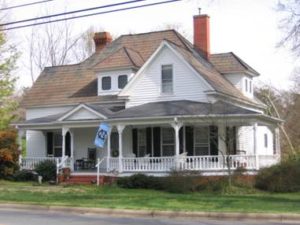
- Name and location of the property: The Armour-Adams House is located at 626 North Main Street in Davidson, North Carolina.
- Name, address, and telephone number of the present owner of the property: The present owners of the Armour-Adams House are
- David Sitton and Camilia Meador
626 North Main Street
Davidson, NC
Representative photographs of the property:
This report contains representative photographs of the property.
- A map depicting the location of the property: The following is a map of the location of the property. The UTM coordinates for the property are 17 514069E 3929184N.
- Current deed book references to the property: The most recent deed to this property is recorded in the Mecklenburg County Deed Book 15850, page 177-179. The tax parcel number of the property is 003-161-04.
- A brief historical sketch of the property: This report contains a brief historical sketch of the property.
- A brief architectural description of the property: This report contains a brief architectural description of the property by Stewart Gray.
- Documentation of why and in what ways the property meets the criteria set forth in NCGS 160A-400: Special significance in terms of historical, architectural, and/or cultural importance:
The Commission judges that the property known as the Armour-Adams House does possess special historic significance for Charlotte-Mecklenburg. The Commission bases its judgment on the following criteria:
- The Armour-Adams House is representative of the evolution of the built environment of Davidson in terms of the emergence of the town’s merchant class.
- The Armour-Adams house is a locally distinctive example of the Folk Victorian style of architecture that was made possible by innovations in technology and transportation, and retains a high degree of integrity.
- The Armour-Adams House was the long-time home of Margaret H. Adams, a beloved first grade teacher for decades at the Davidson Elementary School.
- Integrity of design, setting, workmanship, materials, feeling and/or association.
The Commission judges that the architectural description included in this report demonstrates that the property known as the Armour-Adams House meets this criterion.
- Ad Valorem Tax Appraisal: The current assessed value of the property is $321,000 ($156,300 building; $162,500 land). The property is zoned residential.
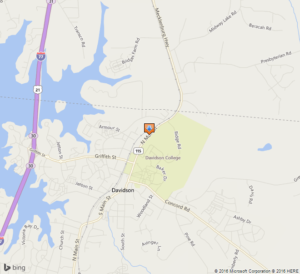
This report was prepared by Jane Starnes and revised by Dr. Dan Morrill and Jennifer Payne.
Date of Report: 24 April, 2006
A Brief Historical Sketch of the Property
The Armour-Adams House, built circa 1900 by Davidson merchant Holt Armour, can best be understood within the context of the evolution of the built environment of Davidson, North Carolina. The two-story, Folk Victorian style dwelling, which faces west on North Main Street, is representative of the shift in Northern Mecklenburg County during the late nineteenth and early twentieth centuries from an agrarian tradition to a way of life that was increasingly rooted in commerce and industry. In Davidson, this change was facilitated by the establishment of Davidson College, and was strengthened by the reactivation of the railroad in 1874. One of the many results of these forces was the emergence of a diverse commercial class in Davidson, of which Holt Armour was a member. In addition, Davidson is a community that has been historically committed to education, and the Armour-Adams house served as the home of a long-time Davidson teacher who was a part of the movement to bring quality education to the children of Davidson.
Prior to the foundation of Davidson College in 1835, the area surrounding Davidson was rural, fertile farmland.[1] Farmers such as Robert Armour lived and worked on large swaths of land. The Armours, whose association with the region dates to as early as the 1820s, acquired holdings that stretched “along North Main Street as far south as the cemetery” and “extended westward beyond the railroad and eastward over the area where Davidson College dormitories and Patterson Court now stand.”[2]
The traditional, agricultural life that families like the Armours lived for generations began to be altered in 1835, when a group of Presbyterians chose the spot as the location of their second attempt at providing higher education imbued with Presbyterian values to the youth of the region. The result of this decision was Davidson College, envisioned as a manual labor institution, and named for William Davidson, who died at the Battle of Cowan’s Ford in the Revolutionary War.[3] The construction of the first College buildings followed; and when Davidson College opened its doors in 1837, several edifices had been constructed for the purposes of housing, educating, and supporting student life. Twelve buildings had been erected on campus by the close of the antebellum period, including the Chapel, five dormitory rows (of which Elm Row and Oak Row alone still stand), Tammany Hall ( a faculty residence destroyed in 1906), the Old Chambers Building (destroyed by fire in 1921), and the President’s House.[4]
The College drew new residents to the town, some from the surrounding rural environs and some who were associated with the faculty and student populations of the school. The re-activation of the railroad in 1874 quickened the pace of the town’s growth, and established the community as the commercial center of northern Mecklenburg County. Residents like the Armour family, who had lived and worked on the land for generations, were drawn to the thriving town in search of new forms of employment in the fledgling merchant class that provided goods and services to the growing population of the town, but whose fortunes were not directly linked to the everyday operations of the College.
The earliest of the Davidson’s merchants was Thomas Sparrow, who operated the first in a long tradition of boarding houses in Davidson.[5] The Helper Hotel, or Carolina Inn, as it is alternatively known, was established in the 1850s by Lewis Dinkins as a store that provided goods to the College population, and was expanded and reestablished as a hotel in the 1860s by Hanson Helper.[6] The commercial sector of Davidson was augmented in 1890, with the construction of the Delburg Cotton Mill, followed in 1908 by the addition of the Linden Cotton Mill. By 1910, Davidson, once a relatively isolated college town, had grown into a thriving commercial and industrial center. Holt Armour took advantage of these circumstances in 1912, when he established Armour Brothers and Thompson, a general retail store that operated out of the brick structure that still stands on the north corner of Brady’s Alley.[7] Armour Brothers and Thompson was one of several local retail and service firms that operated on the North Main Street commercial corridor, and which also included Goodrum and Company, the White Drug Store, the Jetton Drug Store, and the general merchandise firm of Knox and Brown.[8] The commercial district that was established by 1920, and which included the Armour Brothers and Thompson store, retains much of the same character that is evident on North Main Street today, because it was hemmed in to the east by the College, to the north and south by residential development, and to the west by the railroad.[9]
The distinctive Armour-Adams House was erected on a lot that Holt Armour received from his father, Robert Armour, in 1899.[10] Constructed in the popular Folk Victorian style, the Armour Adams House stands as a testament to the innovations in transportation and technology that made the style possible. The movement stemmed from the Victorian-era architectural forms, such as Queen Anne, that were popular in the last decades of the nineteenth century, in combination with the simple and widespread National or vernacular styles that brought more highly stylized dwellings into the reach of the middle class.[11] The advent of the railroads made lumber and machinery more accessible; the use of manufactured nails replaced the hewn joints which required skilled labor. The mechanical jigsaw and lathe were two of the most important innovations which aided the growth of this style, and Queen Anne-like scrollwork and brackets, as well as turned porch supports, which were previously only accessible to a few, were now within the realm of possibility for the masses.[12]
In 1919, Holt Armour purchased from his sister, Margaret Armour, the lot adjoining 626 North Main Street to the north. He sold the original home to J. Hope Adams, who moved with his two adult children to Davidson from York, South Carolina. The Adams family became longtime residents of the town, and J. Hope’ son, Albert, served as mayor from 1931 to 1933.[13]
- Hope’s daughter, Margaret Adams, was a part of the movement in the town to provide a quality education to the town’s children. Just as the Presbyterians were responsible for bringing higher education to Davidson, they were also the force behind the primary education movement for some of the town’s children. Public instruction in Davidson from 1835 until the 1890s was initially reliant upon individual citizens who operated schools out of their homes or buildings provided by the community for the purpose of education. However, by the turn of the century, a movement was well under way to provide a consistent public education to the white children of the town. The cause of public education was spearheaded by the trustees of Davidson College, who in 1892 established the Davidson Academy, which was initially located in the Masonic Hall near the intersection of South Street and South Main Street. The new schoolhouse, which stood on the site of the present Davidson IB Middle School, was completed in 1893 and expanded in 1924.[14] Unfortunately, in a pattern that was familiar to the older residents of Davidson, the expanded school was destroyed by fire in 1946, and classes were held in the gymnasium and in the basement of the Presbyterian Church. Its replacement, which serves today as the Davidson IB Middle School, was completed in 1948.[15] Margaret Adams was a part of the early growth of Davidson education in the twentieth century. She taught generations of first grade students in Davidson from 1930 until her retirement, and is remembered in town as a “diminutive and greatly loved teacher.”[16]
The Armour-Adams House is an illustration of the evolution of the Town of Davidson from the turn of the twentieth century until the present day. Its earliest inhabitant, Holt Armour, was a part of the shift from an agrarian tradition to a town life that was centered on commerce and industry and that was facilitated by the establishment of Davidson College and by the reactivation of the railroad. In its architectural style, the home is evidence of the effect that changes in transportation and technology had on middle class citizens and their ability to build stylized dwellings. Finally, in its connection to Margaret Adams, the home retains a link to the Presbyterian fervor for quality education for the town’s citizens.
[1] Mary D. Beaty, Davidson: A History of the town from1835 to 1927 (Davidson: Briarpatch Press, 1979), 3. Information in this report is taken largely from an initial survey and research report prepared by by Jane Starnes in December, 2005, and from Jennifer Payne and Dr. Dan L. Morrill, “ The Evolution of the Built Environment of Davidson, NC,” available at http://www.cmhpf.org/surveydavidsonpayne.htm.
[2] Ibid., 15.
[3] Cornelia Rebekah Shaw, Davidson College (New York: Fleming H. Revell Press, 1923), 7-16.
[4] Beaty, A History of the Town, 181.
[5] Ibid., 11.
[6] Payne and Morrill.
[7] Beaty, 82.
[8] Starnes; Beaty, 180.
[9] Beaty, 134.
[10] Starnes.
[11] Virginia and Lee McAlester, A Field Guide to American Houses ( New York: Alfred A. Knopf, 1984), 310.
[12] Ibid.
[13] Starnes.
[14] Beaty, 64, 171.
[15] Kristin Stakel and Dr. Dan L. Morrill, “Survey and Research Report on the Davidson IB Middle School,” December, 2005; Beaty, 64.
[16] Ibid., 82.
Architectural Description
The Armour-Adams House is a very well preserved example of late Queen Anne Style architecture. While more restrained in terms of ornamentation than many earlier Queen Anne Style houses, the Armour-Adams House demonstrates the asymmetrical massing and machine-made woodwork typical of the style. In addition, the house is situated in a prominent position on North Main Street. The house has retained a high degree of integrity in terms of its appearance and historic building material.
The house sits close to the sidewalk of North Main Street in Davidson and is setback about 40’ from the street, as are most of the neighboring houses. The house faces west on a lot that slopes down towards the rear of the lot.
The one-and-one-half-story frame house is notable for its asymmetrical massing, and its various roof profiles. One of the house’s prominent features is the one-story wrap-around hipped-roof porch. Unlike the typical pier supports found on many early-twentieth-century house, the porch of the Armour-Adams House is supported a continuous single-wythe curtain wall. Turned post support the porch roof, and are decorated with sawn brackets. Low guardrails connect the posts, and feature turned balusters and a moulded handrail. The porch follows the contour of the house, and projects out from a three-sided projecting bay. The porch is accessed by non-original brick steps. A small gable, featuring a recessed triangular panel, is located over the porch entrance.
Behind the porch, the façade is dominated by a projecting gabled bay that contrasts with a taller hip roof that covers the principal section of the house. The house is three bays wide. A doorway is centered between the three-sided projecting bay on the southern side of the façade, and a single window to the north. The tall windows appear to be original one-over-one double-hung units, with louvered shutters. The façade has retained its original three-panel two-light door. In contrast to the turned woodwork, the fenestration is surrounded with simple trim. All of the exterior walls are covered with simple weatherboard accented with moulded corner boards.
Above the porch, the front gable is pierced with a single narrow double-hung window. The gable is accented with wide and moulded barge and soffit boards, as well as gable returns. Located over the front entrance is a hipped dormer with two swing-in single-light casements with screens decorated with sawn-work. Moulded trim and a wide freeze-board separates the dormer’s siding from the soffit. With the exception of the porch, the house is covered with metal shingles decorated with a fish-scale pattern. Two interior chimneys pierce the roof the northern chimney features a corbelled band, and a corbelled flared top. The southern chimney is plain and of more recent construction.
South Elevation
The south elevation of the original house is only two bays deep, with just two windows piercing the wall. The wrap-around porch extends over only a part of the elevation. A hipped dormer, like the one on the front of the house, is located on the south side of the house. Like the south elevation, the north elevation is simple in comparison with the façade. Just two bays wide with a single window in the north-facing gable, the north elevation demonstrates the brick-pier construction of the foundation, the wide water table, and wide freeze board. An original one-room-deep gabled rear wing is setback slightly from the north elevation.

Front Elevation

Rear Elevation
The rear elevation is the most altered part of the largely original house. A single six-over-six is centered in the rear wall of the rear wing. A similar window is located in the gable. A shed roof extends from south side of the rear wing, and may have once been a porch. An enclosed porch extends from the rear of the hipped-roof principal section of the house. A recent deck is located on the rear of the house. A narrow hipped dormer with a single window is roughly centered over the principal section of the house.














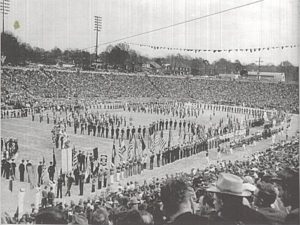
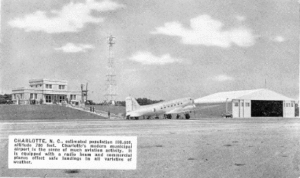
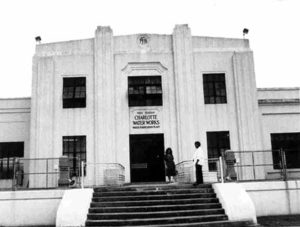 Charlotte’s Best Surviving Example Of The Art Deco Style Is The Charlotte Water Works Vest Station (1924)
Charlotte’s Best Surviving Example Of The Art Deco Style Is The Charlotte Water Works Vest Station (1924)

